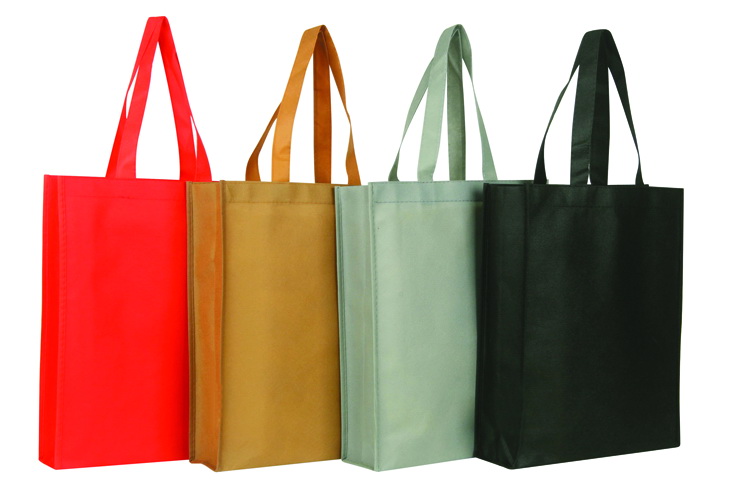The non-woven bags whose tissues are constructed with polypropylene (PP) are renowned for being durable and high quality. Their production requires a tendency to knitting or spinning.
Plastic is a material that is produced through several processes based on oil. It is the main factor in the materials that are made of plastics and can also use another raw material is coal and natural gas, is relied on polyethylene for the manufacture of plastic bags, which consists of a long series of hydrogen and carbon.

The use of plastics is minimized to avoid the risk of a variety of methods:
• Attention to avoid the use of plastic cups and dishes and plastic spoons daily life.
• Avoid using metal or glass cans to store food instead of plastic bags and plastic containers.
• Replace your use of plastic bags with biodegradable cloth and paper bags.
• Be careful not to use plastic bags to put hot food in it because this would lead to food poisoning.
Some users of non-woven bags do not know the difference between non-woven and non-woven polypropylene. Yes, many know that there are different sets of non-woven and non-woven polypropylene fabrics that are used to make reusable and recycled bags.
Non-woven bags made of polypropylene and woven are also used for the production of recycled bags. Both types are characterized by their printability. The plastic from this material is woven together by the traditional manufacturing process to produce a durable material, while non-woven fibers are created by bonding them together.
Be aware that the cost of non-woven bags is lower than the cost of woven bags.
Some benefits of non-woven bags:
• It is cleanable and easily.
• It is environmentally friendly bags, unlike plastic bags.
• It is a durable tool and its ability to survive a very large period of use.
• It is a cost-effective tool.
• Made of environmentally friendly materials.
• Tools accept printing such as the company logo.
Eco-friendly non-woven bags:
Since the use of these reusable materials reduces the chances of using disposable tools such as plastic bags harmful to the environment, we all know how much damage these bags cause to animals, whether water or on the ground and its negative impact on the atmosphere, it consists of a material ( Polyethylene) is a long series of hydrogen and carbon atoms, as these materials need a lot of years to be analyzed naturally resorts to burning and this negatively affects the air and water and leads to an increase in the ozone hole, so the majority of countries in the world using bags Eco-friendly (non-woven bags).
Disadvantages of using plastic bags:
The plastic bags have been warned by the Executive Director of the Association for the Conservation of the Environment and the reduction of their use, as the resulting waste is a great burden because it does not decompose, from which chemical compounds form a cloud that affect the Eve and increase the ozone hole, and warned of diseases that produce Perhaps most notably:
• They cause infertility.
• Cause poisoning.
• Cause skin problems.
• Long-term disorders of mental abilities can occur.
• Weak immune system.
• Hormonal and gland disorders.
• Increased fat storage (especially as it is easy to dissolve fatty substances inside the human body and this leads to cancer and fetal deformity in the long run).
• Strikes resulting from the nervous system.
• Increases the risk of cancer due to the dioxin content as this substance is classified as carcinogenic.
Plastic products include many organic materials, such as vinyl chloride (PVC) and BPA, which reduce the hormone testosterone, but it contains high levels of lead, which causes harmful gases when throwing these bags in the sun, as well as plastic toys for children Ethylene is used to cause disturbances by secreting some of the body’s hormones and weakening the immune system. Plastic bags are manufactured based on a substance called (dioxin), one of the most toxic organic chemicals classified as carcinogens.
Some users of polypropylene:
They are used in various styles, usually non-woven fabrics, and it is important that the non-woven fabric can be recycled.
Some properties of polypropylene:
Polypropylene is a coarse material and has the ability to resist other chemicals but it is flexible. This makes the material you use to be easy for chemical experiments. This material is a transparent fabric but there are many who use this material as dyed fabric.
Polypropylene melts about 320 degrees Fahrenheit, which is dissolved as soon as the chemical is bonded by narrow pulleys that produce the tissue thinly. Non-woven polypropylene is a miracle tissue.
Many countries have tended to ban the use of plastic bags and each has its own laws. The state of application of the ban varies from city to state. For any questions read our frequently asked questions.
